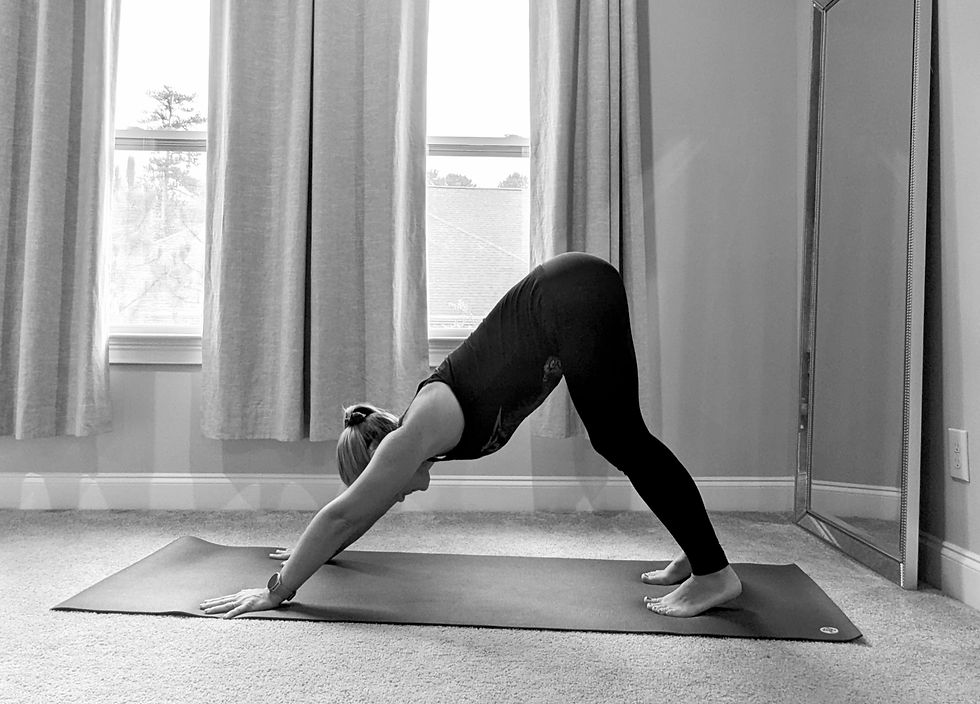Centered in the Saddle: 10 Yoga Poses for Equestrians
- Katie Cousins
- Jul 15
- 4 min read
As an adult amateur equestrian focused on classical dressage and natural horsemanship, I’ve learned that riding isn’t just about strength or technique; it’s about awareness.
Intention. Breath. Emotional regulation.
All of which, as it turns out, are things I’ve also learned on my yoga mat.
Yoga has become an integral part of my training, not just physically, but also mentally and emotionally. It helps me build core strength, flexibility, and body awareness, yes, but more than that, it teaches me to be present, to breathe through challenges, and to communicate more clearly with my horse.
Because the truth is, riding well isn’t just about what you do, it’s about the energy you bring into the saddle.
The Horse-Human Connection: Reactivity and Regulation
Horses are prey animals. They’re highly sensitive to energy, emotion, and nonverbal cues. They respond to what you feel, even more than what you do. And they mirror your internal state right back to you, sometimes beautifully, sometimes humblingly. The horse, much like a yoga mat, becomes a very honest mirror.
If you're anxious, distracted, or physically tense, they’ll pick up on it. They may become reactive or shut down. If you pause, soften, and breathe, they will too.
Teaching a horse to self-regulate takes patience and presence. But it’s no different from teaching ourselves. I see it every time I ride my horse, Sassi. When I meet her with steadiness and ease, rather than pressure, and remember to breathe and give her space, she responds with trust and calm.
It’s not about perfection. It’s about presence.
Why Yoga Helps Riders: Beyond Flexibility
Yoga teaches you how to:
Anchor your awareness in your breath and body
Strengthen your deep core and postural muscles
Loosen areas of chronic tightness (especially hips, hamstrings, and low back)
Balance effort and ease on the mat, in the saddle, and in life
Respond rather than react to your horse, to a spook, to a mistake
When you train your nervous system on the mat, it shows up in the saddle. You’ll recover more quickly from moments of stress. You’ll ride with more softness and intention. You’ll communicate more clearly because you’ll be more in tune with yourself.
10 Yoga Poses Every Equestrian Should Practice
These yoga poses support the muscles and mindset of equestrians, whether you’re riding a dressage test or trail riding on the weekend.
Cat-Cow (Marjaryasana-Bitilasana)
Gently warms up the spine and helps riders become more aware of posture and breath.


Why it matters: Spinal articulation improves your ability to move with your horse’s motion instead of bracing against it.
Downward Facing Dog (Adho Mukha Svanasana)
A full-body stretch that lengthens the back, opens the shoulders, and releases tight hamstrings and calves.

Why it matters: Relieves lower back tension and supports better riding posture and leg alignment.
Low Lunge (Anjaneyasana)
Opens up the hip flexors and strengthens the glutes and thighs.

Why it matters: Long hours in the saddle shorten the front body. Opening the hips helps improve pelvic alignment and leg position.
Chair Pose (Utkatasana)
Builds lower body strength and endurance while engaging the core.

Why it matters: Mimics the strength and engagement needed for a secure yet supple seat.
Boat Pose (Navasana)
Strengthens the deep abdominal muscles and encourages upright posture.

Why it matters: A strong core is essential for stability and clear communication with the horse.
Tree Pose (Vrksasana)
Improves balance, focus, and postural alignment.

Why it matters: Lifting through the crown of the head while grounding through the standing foot mimics the long spine and intentional gaze needed in the saddle. Balance in stillness translates to balance in motion. Eyes up, spine tall, energy rooted.
Bound Angle Pose (Baddha Konasana)
Stretches the inner thighs, groin, and hips.

Why it matters: Helps release the common tension caused by gripping with the inner thighs. Great for post-ride recovery and low back release.
Garland Pose (Malasana)
A deep hip opener that also stretches the ankles and lower back.

Why it matters: Promotes mobility in the hips and pelvic floor—essential for a deep, effective seat.
Half Pigeon (Eka Pada Rajakapotasana)
Targets deep outer hip tension, especially useful after riding.


Why it matters: Tight hips reduce your ability to absorb shock and follow your horse’s movement smoothly.
Constructive Rest + Breathwork
Lie on your back with knees bent and feet on the floor. Practice slow, intentional breathing.

Why it matters: This trains your nervous system to shift into parasympathetic (rest and digest) mode, which helps with focus, emotional regulation, and energy conservation.
Final Thoughts: Train the Breath, Lead with Presence
In both yoga and riding, how you show up matters. The breath is the thread that connects body to mind, rider to horse.
When you learn to pause and breathe through discomfort, you teach your body to stay present. You teach your horse that they are safe. And you teach yourself that regulation, not control, is the real path to partnership.
Whether you ride once a week or every day, integrating yoga into your routine is one of the best things you can do for your body, your mindset, and your horse.
xo,
Katie Cousins
e-RYT Certified Yoga Instructor
Adult Amateur Equestrian
Want to practice with me? Check out my yoga schedule to see when and where I'll be teaching yoga in Pittsboro and the surrounding areas.

























Comments